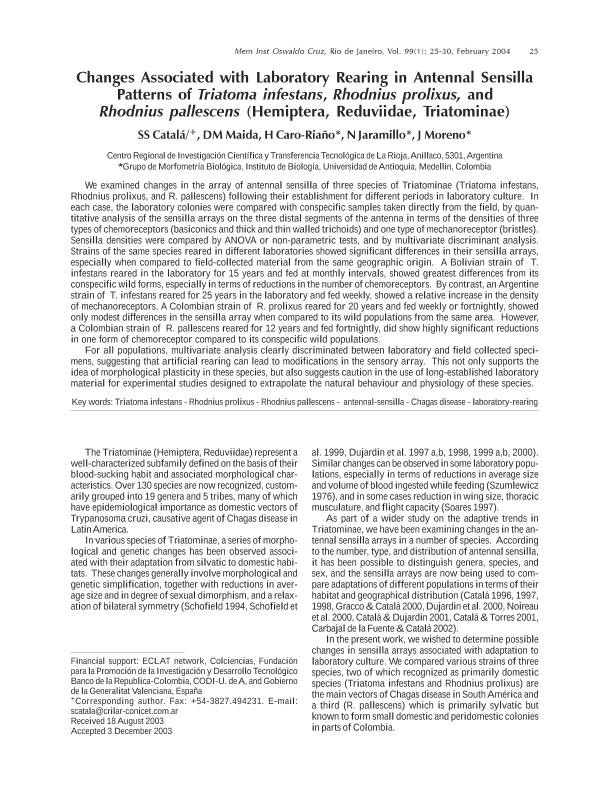Mostrar el registro sencillo del ítem
dc.contributor.author
Catala, Silvia Susana

dc.contributor.author
Maida, D. M.
dc.contributor.author
Caro Riaño, H.
dc.contributor.author
Jaramillo, N.
dc.contributor.author
Moreno, J.
dc.date.available
2019-08-08T20:48:23Z
dc.date.issued
2004-12
dc.identifier.citation
Catala, Silvia Susana; Maida, D. M.; Caro Riaño, H.; Jaramillo, N.; Moreno, J.; Changes associated with laboratory rearing in antennal sensilla patterns of Triatoma infestans, Rhodnius prolixus, and Rhodnius pallescens (Hemiptera, Reduviidae, Triatominae); Fundação Oswaldo Cruz; Memórias do Instituto Oswaldo Cruz; 99; 1; 12-2004; 25-30
dc.identifier.issn
0074-0276
dc.identifier.uri
http://hdl.handle.net/11336/81274
dc.description.abstract
We examined changes in the array of antennal sensilla of three species of Triatominae (Triatoma infestans, Rhodnius prolixus, and R. pallescens) following their establishment for different periods in laboratory culture. In each case, the laboratory colonies were compared with conspecific samples taken directly from the field, by quantitative analysis of the sensilla arrays on the three distal segments of the antenna in terms of the densities of three types of chemoreceptors (basiconics and thick and thin walled trichoids) and one type of mechanoreceptor (bristles). Sensilla densities were compared by ANOVA or non-parametric tests, and by multivariate discriminant analysis. Strains of the same species reared in different laboratories showed significant differences in their sensilla arrays, especially when compared to field-collected material from the same geographic origin. A Bolivian strain of T. infestans reared in the laboratory for 15 years and fed at monthly intervals, showed greatest differences from its conspecific wild forms, especially in terms of reductions in the number of chemoreceptors. By contrast, an Argentine strain of T. infestans reared for 25 years in the laboratory and fed weekly, showed a relative increase in the density of mechanoreceptors. A Colombian strain of R. prolixus reared for 20 years and fed weekly or fortnightly, showed only modest differences in the sensilla array when compared to its wild populations from the same area. However, a Colombian strain of R. pallescens reared for 12 years and fed fortnightly, did show highly significant reductions in one form of chemoreceptor compared to its conspecific wild populations. For all populations, multivariate analysis clearly discriminated between laboratory and field collected specimens, suggesting that artificial rearing can lead to modifications in the sensory array. This not only supports the idea of morphological plasticity in these species, but also suggests caution in the use of long-established laboratory material for experimental studies designed to extrapolate the natural behaviour and physiology of these species.
dc.format
application/pdf
dc.language.iso
eng
dc.publisher
Fundação Oswaldo Cruz

dc.rights
info:eu-repo/semantics/openAccess
dc.rights.uri
https://creativecommons.org/licenses/by-nc-sa/2.5/ar/
dc.subject
Antennal-Sensilla
dc.subject
Chagas Disease
dc.subject
Laboratory-Rearing
dc.subject
Rhodnius Pallescens
dc.subject
Rhodnius Prolixus
dc.subject
Triatoma Infestans
dc.subject.classification
Zoología, Ornitología, Entomología, Etología

dc.subject.classification
Ciencias Biológicas

dc.subject.classification
CIENCIAS NATURALES Y EXACTAS

dc.title
Changes associated with laboratory rearing in antennal sensilla patterns of Triatoma infestans, Rhodnius prolixus, and Rhodnius pallescens (Hemiptera, Reduviidae, Triatominae)
dc.type
info:eu-repo/semantics/article
dc.type
info:ar-repo/semantics/artículo
dc.type
info:eu-repo/semantics/publishedVersion
dc.date.updated
2019-08-07T21:07:58Z
dc.identifier.eissn
1678-8060
dc.journal.volume
99
dc.journal.number
1
dc.journal.pagination
25-30
dc.journal.pais
Brasil

dc.journal.ciudad
San Pablo
dc.description.fil
Fil: Catala, Silvia Susana. Consejo Nacional de Investigaciones Científicas y Técnicas. Centro Regional de Investigaciones Científicas y Transferencia Tecnológica de La Rioja. - Universidad Nacional de La Rioja. Centro Regional de Investigaciones Científicas y Transferencia Tecnológica de La Rioja. - Universidad Nacional de Catamarca. Centro Regional de Investigaciones Científicas y Transferencia Tecnológica de La Rioja. - Secretaría de Industria y Minería. Servicio Geológico Minero Argentino. Centro Regional de Investigaciones Científicas y Transferencia Tecnológica de La Rioja. - Provincia de La Rioja. Centro Regional de Investigaciones Científicas y Transferencia Tecnológica de La Rioja; Argentina
dc.description.fil
Fil: Maida, D. M.. Consejo Nacional de Investigaciones Científicas y Técnicas. Centro Regional de Investigaciones Científicas y Transferencia Tecnológica de La Rioja. - Universidad Nacional de La Rioja. Centro Regional de Investigaciones Científicas y Transferencia Tecnológica de La Rioja. - Universidad Nacional de Catamarca. Centro Regional de Investigaciones Científicas y Transferencia Tecnológica de La Rioja. - Secretaría de Industria y Minería. Servicio Geológico Minero Argentino. Centro Regional de Investigaciones Científicas y Transferencia Tecnológica de La Rioja. - Provincia de La Rioja. Centro Regional de Investigaciones Científicas y Transferencia Tecnológica de La Rioja; Argentina
dc.description.fil
Fil: Caro Riaño, H.. Universidad de Antioquia; Colombia
dc.description.fil
Fil: Jaramillo, N.. Universidad de Antioquia; Colombia
dc.description.fil
Fil: Moreno, J.. Universidad de Antioquia; Colombia
dc.journal.title
Memórias do Instituto Oswaldo Cruz

dc.relation.alternativeid
info:eu-repo/semantics/altIdentifier/doi/http://dx.doi.org/10.1590/S0074-02762004000100005
dc.relation.alternativeid
info:eu-repo/semantics/altIdentifier/url/http://ref.scielo.org/vqpbh9
dc.relation.alternativeid
info:eu-repo/semantics/altIdentifier/url/https://memorias.ioc.fiocruz.br/article/2058/changes-associated-with-laboratory-rearing-in-antennal-sensilla-patterns-of-triatoma-infestans-rhodnius-prolixus-and-rhodnius-pallescens-hemiptera-reduviidae-triatominae
Archivos asociados
